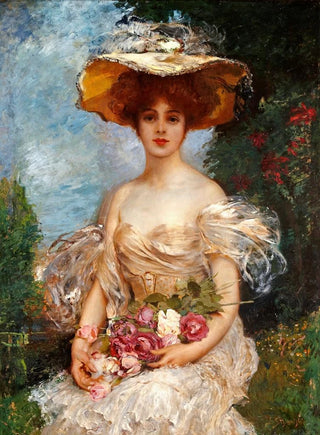Art print | A portrait of an elegant woman - Leopold Schmutzler


View from behind

Frame (optional)
In the rich and fascinating universe of art, some works stand out as silent witnesses to a particular era, culture, or emotion. "An elegant woman portrait" by Leopold Schmutzler is undoubtedly one of these masterful pieces. This painting, which captures the very essence of femininity and grace, transports the viewer into a world where elegance reigns supreme. The delicacy of the features of the depicted woman, combined with a subtle play of light and shadow, creates an intimate and captivating atmosphere. Through this portrait, Schmutzler does not merely paint an image; he tells a story, that of a woman embodying beauty and mystery.
Style and uniqueness of the work
Leopold Schmutzler's style is distinguished by his ability to blend tradition and modernity. In "An elegant woman portrait," the artist uses a palette of soft colors, where pastel tones blend harmoniously to evoke a sense of serenity. The meticulous details of the woman's clothing, as well as the delicate expression on her face, testify to remarkable craftsmanship. Schmutzler excels in representing textures, making the silk of the dress and the softness of the skin almost palpable. This portrait is not limited to a simple representation; it becomes an exploration of feminine identity, a tribute to timeless beauty. The balanced composition, where the blurred background highlights the main subject, reinforces this impression of depth and life, inviting the viewer to delve into the woman's inner universe.
The artist and his influence
Leopold Schmutzler, born in 1864, is an artist whose work marked the early 20th century. Influenced by the great masters of the past, he developed a style that is uniquely his own, combining realism and romanticism. His ability to capture emotions on canvas made him a sought-after portraitist, especially within the aristocratic circles of his time. Schmutzler transcended the conventions of his era, bringing a touch of modernity to portrait painting. His influence

Matte finish

View from behind

Frame (optional)
In the rich and fascinating universe of art, some works stand out as silent witnesses to a particular era, culture, or emotion. "An elegant woman portrait" by Leopold Schmutzler is undoubtedly one of these masterful pieces. This painting, which captures the very essence of femininity and grace, transports the viewer into a world where elegance reigns supreme. The delicacy of the features of the depicted woman, combined with a subtle play of light and shadow, creates an intimate and captivating atmosphere. Through this portrait, Schmutzler does not merely paint an image; he tells a story, that of a woman embodying beauty and mystery.
Style and uniqueness of the work
Leopold Schmutzler's style is distinguished by his ability to blend tradition and modernity. In "An elegant woman portrait," the artist uses a palette of soft colors, where pastel tones blend harmoniously to evoke a sense of serenity. The meticulous details of the woman's clothing, as well as the delicate expression on her face, testify to remarkable craftsmanship. Schmutzler excels in representing textures, making the silk of the dress and the softness of the skin almost palpable. This portrait is not limited to a simple representation; it becomes an exploration of feminine identity, a tribute to timeless beauty. The balanced composition, where the blurred background highlights the main subject, reinforces this impression of depth and life, inviting the viewer to delve into the woman's inner universe.
The artist and his influence
Leopold Schmutzler, born in 1864, is an artist whose work marked the early 20th century. Influenced by the great masters of the past, he developed a style that is uniquely his own, combining realism and romanticism. His ability to capture emotions on canvas made him a sought-after portraitist, especially within the aristocratic circles of his time. Schmutzler transcended the conventions of his era, bringing a touch of modernity to portrait painting. His influence






